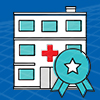Blog
Triple threat: How technology, training, and tenacity transformed a hospital contact center
Gregg Aguilar is on a mission to transform the contact center at the University of New Mexico Hospital (UNMH) into a customer engagement center. He wants to elevate the contact center from transactional “answer and transfer” responsibilities to comprehensive services that consistently deliver value to patients and providers with “100 percent customer service, every call.”
As the state’s only academic medical center, the primary teaching hospital for the university’s School of Medicine, UNMH provides care to a large and diverse population, with more than 491,000 patient visits annually. The organization has a mission to provide accessible, high-quality, and safety-focused care for its patients, and oftentimes, accessibility starts with the real front door to the hospital: the contact center.
The UNMH contact center, led by Gregg Aguilar, communications supervisor, has leveraged Spok contact center for over 15 years to deliver excellent service to patients and their families, as well as UNMH clinicians and staff.
But both UNMH and Gregg aren’t content to rest on laurels. With the goal to transform the contact center into a customer engagement center, Gregg began researching ways to innovate.
Technology: healthcare-grade call recording
Since 2004, UNMH has leveraged the Spok operator console to increase agent productivity, connect staff, and field calls from patients and other external callers quickly and accurately. Gregg and his 12 agents love the user-friendly screens that contain all of the necessary information, quick, color-coded keyboard shortcuts, message templates, and healthcare-specific workflow assistance, such as on-call rosters.
But the contact center had a technology gap: call recording. Call recording helps ensure the highest levels of customer service for every call, supports regulatory compliance, elevates hospital reputation, and much more. Gregg and his team were complementing the operator console software with call recording, but it was an outdated solution that was cumbersome to use. The user interface had check boxes that required clicking to ensure call recording, the audio quality was substandard, and sometimes recordings wouldn’t pull up on demand.
In 2017, Gregg reached out to Spok to find a more intuitive solution for his team, and Spok recommended its partner, HigherGround. HigherGround offers a reliable and full-featured call recording solution called Calibre to record, report, and analyze calls and associated multi-media interactions. In addition, Calibre provides management with superior training capability using quality assurance tools.
Calibre was a favorite in the public safety space, and was already making inroads in healthcare when Gregg began evaluating it. Gregg said the public safety references for HigherGround helped bolster his purchasing decision.
“Both healthcare and public safety are in the business of critical communications,” Gregg explained. “The solution was so intuitive and worked virtually flawlessly for these life-saving professionals, so we knew this was the answer for us.”
Training: The art of listening
Gregg immediately knew one of the first use cases for Calibre would be as an agent training tool. While UNMH agents reliably delivered information to callers, sometimes it took a while to understand the caller’s request or operators didn’t always deliver information with the right tone of voice.
“We were getting feedback that callers didn’t appreciate the agent’s tone, that they didn’t fully understand the question they were asking or information they were seeking,” Gregg said. “Recognition and empathy are important in all contact centers, but especially in healthcare, and we wanted to be sure we were conveying that to every caller.”
With Calibre, Gregg can search recording by operator, extension, console name, or a date or time range. Additionally, he can jump into the recording at any point. For the first six months with the solution, Gregg focused on the calls that resulted in negative feedback from the caller. Before Calibre, he would often have to take his agents’ word for how they handled the call. Now, he could hear for himself and determine if operators needed more training.
“It was astounding—all 12 agents, 100 percent said ‘Wow, I didn’t know I sounded that way,’” Gregg said. “It was an immediate gamechanger. They now have a much better understanding of our customers.”
Now, agents request the feedback so they can continue to progress. Gregg pulls random calls on a routine basis and sends the recordings with feedback for improvement. Calibre allows him to grade and score calls and other interactions and provide coaching notes. In addition to tone of voice, they’ve zeroed in on keywords they want to use consistently and eliminated a lot of ‘ums’ and ‘ahs’ from conversations.
Through an integration with the centralized scheduling center, Gregg also trained his agents to engage patients more by asking about their upcoming appointments and fielding requests to change or cancel appointments. Previously, if a patient called after the centralized scheduling center was closed, the agents couldn’t assist. Now, they can deliver scheduling information to patients and make notes of changes in the schedule, rather than requesting the patient call back the next morning.
Tenacity: relentless pursuit of excellence
Gregg didn’t want to stop the improvement at outside calls: He wanted to elevate the service the contact center provides internally, too. The UNMH contact center does a lot of after-hours physician answering and paging. The old workflow required the operator to take a handwritten message, dial the pager, listen for tone, and enter the message. When the physician returned the call, they were put in the general queue, mixed in with external calls.
With the Spok operator console and Calibre, UNMH pages physicians more quickly with pre-defined templates and automatically diverts return calls to a specific operator that answers high priority calls from the physicians. As a result, UNMH reduced the page to connection time by 60 percent.
In 2019, UNMH began answering all external and internal calls to its Emergency Departments. Previously, all calls were going directly to ED locations, which were not adequately staffed for the call volume. A survey of patients who called the ED revealed that 75-80 percent of complaints were because the caller wasn’t getting connected at all, and of those who were connected, 90 percent were unable to get to the right place or obtain the right information.
UNMH was able to centralize emergency calls with Spok: The contact center agents know when a call is intended for the ED and can quickly deliver information to that patient or family member. Additionally, Gregg pursued getting each patient care “pod,” or exam room, in the ED connected to the contact center. Now, when a family member asks about their loved one, the agent can see that patient is in exam room 15, tap that into the Spok operator console, and do a warm transfer to the nurse assigned to that room.
This addition led Gregg to leverage Calibre to provide feedback to nurse leaders as well: Not all charge nurses were happy about answering these new calls, and some calls were ignored and others received terse responses. When Gregg raised the issue, the nursing leaders initially pushed back, saying that they didn’t believe their nurses were ignoring calls or speaking to patients in an unsatisfactory manner. With Calibre, Gregg could prove it.
“Once they heard it for themselves, the nurse leaders said ‘you know what, we’re going to work on it,” Gregg said. “To deliver excellent customer service, everyone needs to be representing the mission of UNMH in every call.”
Results: A top-notch customer engagement center
With the right technology, training, and tenacity, UNMH achieved impressive results:
- Average time to answer: Reduced by 77 percent (13 seconds to < 3 seconds)
- Average talk time: Reduced by 30 percent
- Average physician answering service page to connection time: Reduced by 60 percent
- Average contact center agent call score: Improved by 80 percent (average score of 2.5/5 to an average score of 4.5/5)
But beyond these quantitative results, UNMH has also retained talent in the contact center and increased agent productivity, expanded its ability to provide services to other departments, improved patient satisfaction scores, and provided a better all-around customer experience internally and externally.
Gregg’s biggest takeaway for his fellow contact center leaders? If you don’t have call recording in your contact center today, act quickly. He notes that many top 100 hospitals don’t have call recording at all, and others don’t have a solution of the same caliber HigherGround provides, relying on a consumer application that’s not designed for critical communications.
“If you don’t have call recording, you’ve already waited too long and need to get it,” Gregg said, “Nowadays, you’ve got to have it; you’ve got to hold your agents—and everyone in your organization—accountable to the way they interact with patients. You can leverage it again and again to provide a better patient experience.”






